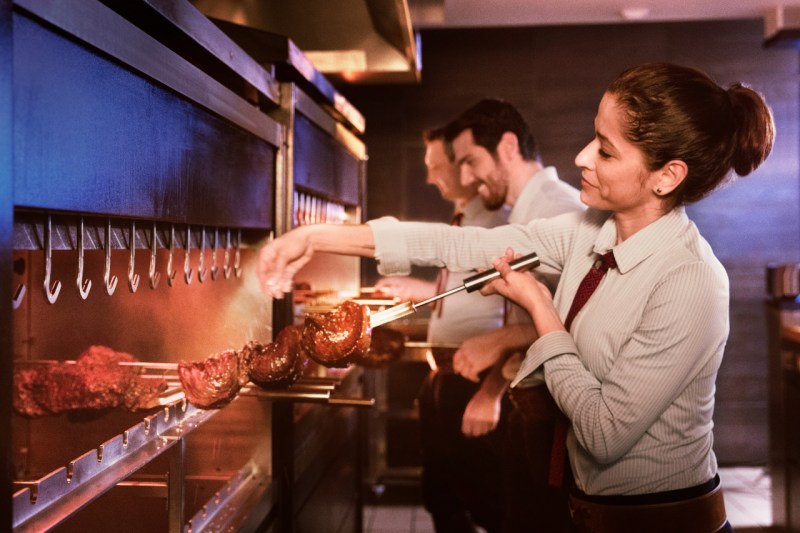
With an endless parade of grilled meats, all carved tableside, Brazilian BBQ is a must-try for any meat eater. Brazilian BBQ, known as churrascaria in Brazil, is unlike smoked American barbecue or Korean barbecue; it actually features large chunks of slow-cooked meat presented tableside on sword-like metal skewers.
To help us with this guide, we’re featuring recipes and insight from iconic Brazilian steakhouse Fogo de Chão. These restaurants are a meat marathon and guaranteed to scratch the itch of any carnivore.
History
Cattle ranching first appeared in Brazil 400 years ago in the southern Rio Grande do Sul region. These cattle ranchers, called gauchos, created a unique form of barbecue — the meat was roasted over wood and seasoned simply with salt. Barbecue culture spread in the 1940s as individuals from Rio Grande do Sul started to open barbecue restaurants throughout Brazil.
Traditionally, Brazilian meat is cooked slowly over wood embers. However, most modern Brazilian BBQ restaurants, the all-you-can-eat steakhouses, will cook their meat on racks in specially designed metal rotisserie grills. The fattier cuts are usually placed on top, allowing the fat to baste the meats below.
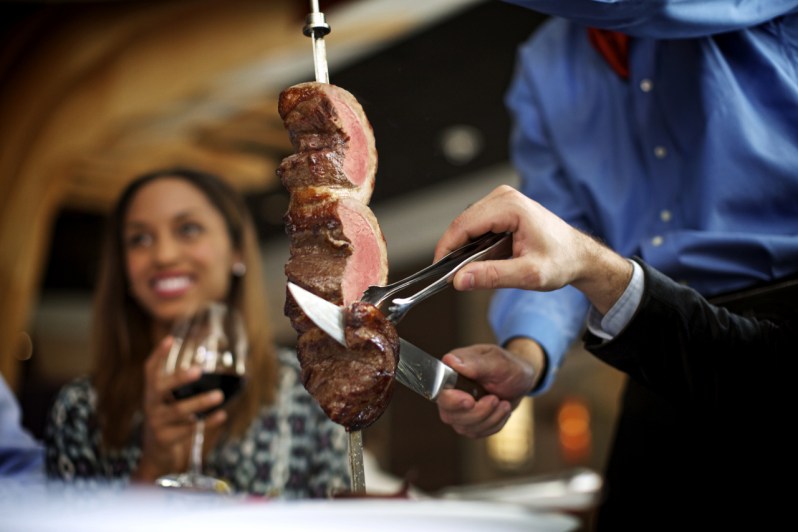
What’s different about Brazilian BBQ?
While Americans might be familiar with sauce-laden meats at a barbecue, Brazilian BBQ is not that affair. What makes Brazilian BBQ distinctive is the salt. Of course, this isn’t table salt — it’s sal grosso, a coarse rock salt. The texture and flavor of sal grosso accentuate the natural flavor of meat, although the crunchy texture might be strange to the American palate.
There are different schools of thought regarding the timing of the seasoning. Some Brazilian BBQ chefs prefer to salt right before grilling, and others believe the best time is after the meat has been cooked briefly. Some chefs even use a saltwater baste, insisting that this method keeps the meat moist during grilling.
The use of only salt is deliberate — churrascaria is all about maintaining the pure flavor of the meat. However, Brazilian BBQ is more than just beef; poultry, lamb, and pork are popular and can be spiced or marinaded.
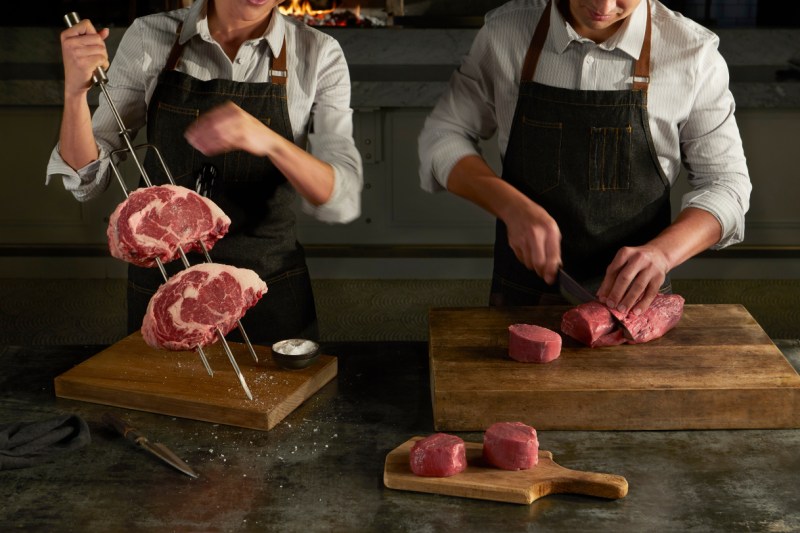
The meat
The joy of Brazilian BBQ is centered around the endless variety of meat. But this endless quantity can also be intimidating. Although many cuts of beef, such as ribeye and filet mignon, will be familiar to American diners, Brazilian BBQ will feature unique cuts like picanha. The following cuts are considered the must-eats of any Brazilian BBQ experience.
Picanha
By far the most popular cut in Brazilian BBQ, picanha is an excellent combination of meat and fat. Also called sirloin cap or culotte, the picanha is cut from the cow’s rump and is considered the premium cut on the sirloin. According to Fogo de Chão, one “1 1/2-pound piece of top sirloin cap should yield four similar sized steaks. (5 to 6 ounces each)” and the meat should be sliced “against the grain of the meat into steak portions, making sure every piece has a 1/4 to 1/2 inches of fat cap on top.”
The fat of picanha is unique because there is no tendon or gristle between the meat and fat cap. This gives the cut a pleasing mouthfeel without any unpleasant gristle. The iconic image of Brazilian BBQ, picanha is grilled folded into a “C” shape on the metal skewer and best served sliced thin.
Filet mignon
Because of the Brazilian preference for lean cuts, the filet mignon is a popular choice for barbecue. The filet is also frequently accentuated with different flavors, appearing with a Parmesan crust or wrapped in bacon. Also, since Brazilian BBQ features multiple cuts, diners are free to mix leaner cuts like filet with fattier cuts such as ribeye for different flavor combinations.
Lombo (pork loin)
Besides beef, pork also is common. A popular item is pork loin sliced thin and seasoned with sal grosso. Besides the standard salt seasoning, pork loin can also be grilled with spices or a Parmesan crust.
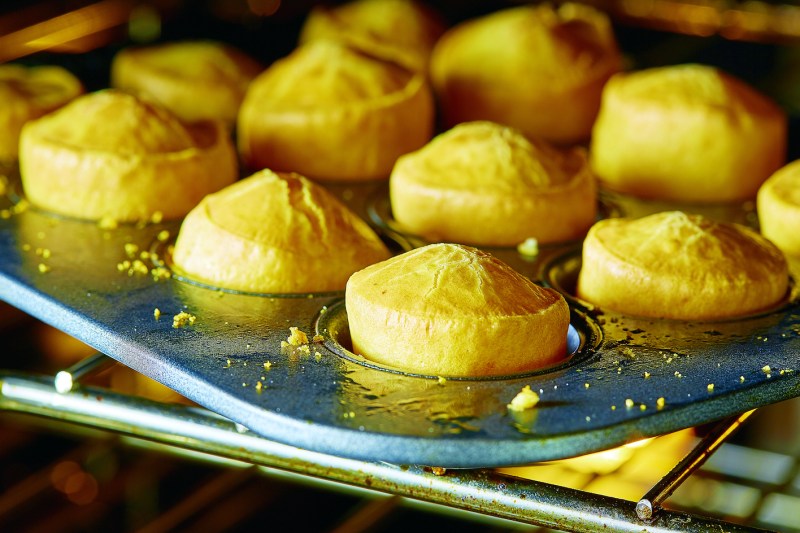
Sides
Most Brazilian BBQ restaurants are all-you-can-eat buffets featuring a plethora of side dishes and salads. These side dishes include rice and beans, french fries, sweet plantains, and fried polenta cakes. A popular side dish is pão de queijo, a puffy cheese bread with a spongy texture due to tapioca flour.
There are two essential accompaniments to Brazilian BBQ — molho campanha and farofa. Molho campanha, which resembles Mexican pico de gallo, is a vinaigrette sauce made from red and green peppers, onions, tomatoes, and vinegar. The sauce’s acidity is a great compliment to the meat’s richness. Farofa is a powder of toasted yucca flour that adds texture to meat and other dishes.
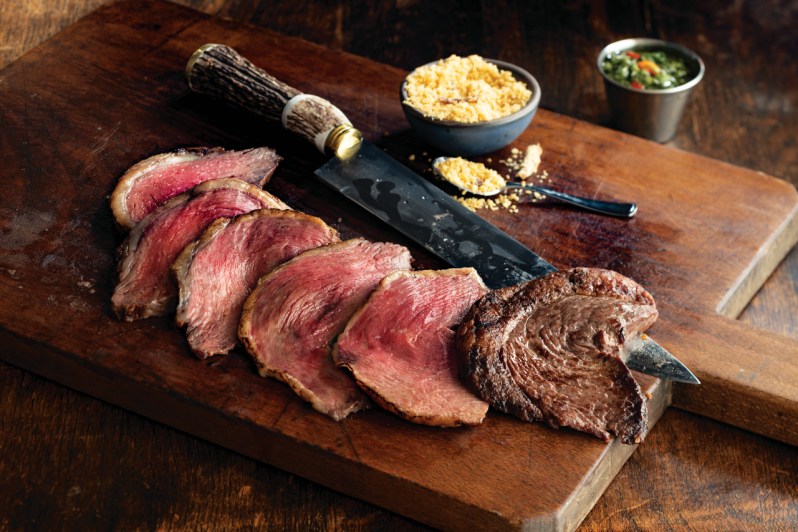
Fogo de Chão picanha
The picanha at Fogo is wet-aged in-house for a minimum of 21 days. The restaurant also features dry-aged meat, aging it for at least 42 days. For the best bite, serve picanha with plenty of chimichurri and farofa.
Ingredients:
- 1 1/2 pounds of top sirloin cap
- 1 teaspoon of sea salt
Method:
- Allow picanha steaks to temper for 20 minutes.
- Sprinkle sea salt on both sides of each steak.
- Spray a hot char grill with nonstick spray and place the steaks on the grill.
- Grill between 3 and 4 minutes over high heat and then move the steaks to a lower temperature for another 5 to 6 minutes, depending on the desired doneness.
Fogo de Chão chimichurri
Ingredients:
- 1 cup of finely chopped parsley
- 3-4 garlic cloves
- 1/8 finely chopped red bell pepper
- Pinch of oregano (to taste)
- 1/4 cup of white wine vinegar
- 1/4 cup of olive oil
- Salt (to taste)
Method:
- Remove stems from the parsley.
- Blend the parsley and garlic cloves in a food processor.
- Finely chop red bell peppers.
- Mix all ingredients together in a large mixing bowl, adding salt to taste
- Present in a serving bowl with a spoon and enjoy on a variety of meats or anything else!
Editors' Recommendations
- What is caviar? A seafood expert breaks down all the details
- The chromium benefits you should know about (and the best food sources for you)
- How to order a Martini like you know what you’re doing
- Burnt ends are already the BBQ favorite for the summer (and we’ve got a killer recipe)
- Did you know you can cure prosciutto at home?




